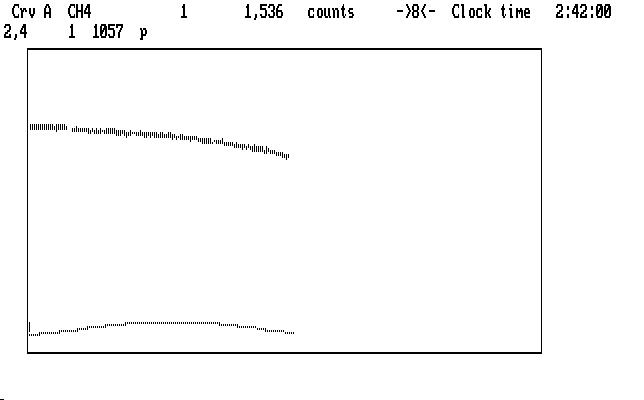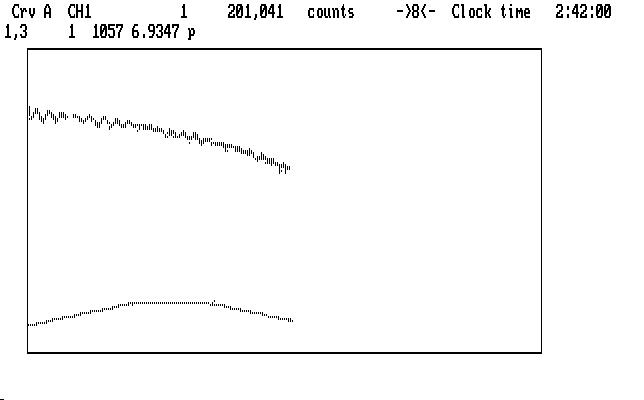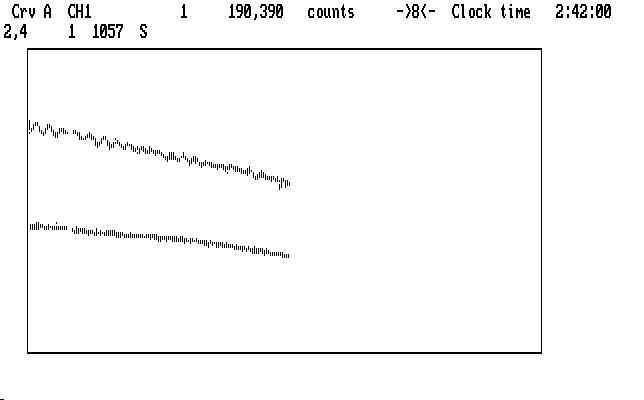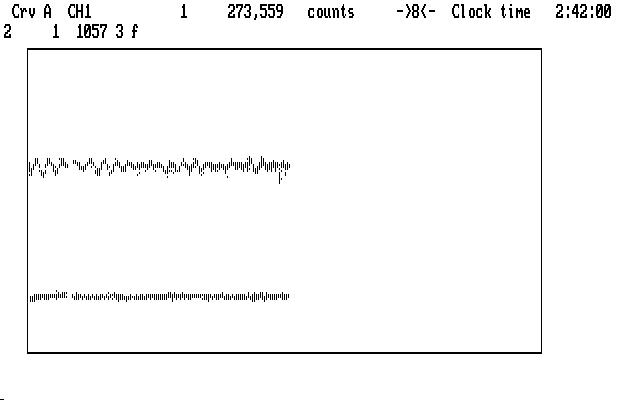
| Previous Page | Contents | Next Page |
Interrupting the Ch1 light curve to take sky, creating an unwanted data gap, has always been painful, and is one of the reasons for the Texas photometer's evolution to a three channel instrument. It's possible to minimize the loss of Ch1 data by taking a series of sky measurements using Ch2 (only), and then applying them to Ch1 during the reduction process. The Ch2 detector in the Texas photometer is mounted on the eyepiece, which itself is on an X-Y carriage capable of motion independent of the Ch1 detector. If sky data are taken this way, then Ch1 need be interrupted only for one sky measurement (to calibrate the relative sensitivity of the two detectors).
The basic reduction procedure is this: starting with Ch2, extract its sky readings (the 't' command), prepare them by interpolation ('p'), and then copy them into the sky buffer for Ch1. If the Ch1 data are now reduced, Qed will note that there is already sky in buffer 3 (it carefully distinguishes between data with all zeroes, for example, and no data at all), so the 't' command on Ch1 will compute (and display, if encouraged to do so) the ratio between Ch1 and Ch2 detectors (Qed will call it the Ch1/Ch3 ratio, because that's where it found the sky data). The 'p' command will then correct the sky by multiplying by the derived sensitivity ratio. It's possible to do all this one step at a time, but it involves a lot of display manipulation and is easy to get wrong. Qed tries to make it easier: the 'Alt-t' command on Ch1 does the copying for you. The sequence then becomes
where the starting 'Alt-2' puts the Ch2 data into Crv B and puts the cursor on it, and the 'Alt-T' command does the copy process, puts the cursor back on Ch1, and then does the 't' command. We are now ready to subtract the sky and do the extinction correction, separately or on both channels as we choose.
Let's reduce a run where we do this. Here's what the run looks like:

| Fig. R01 |
Before we start, however, we note the first part of the Ch1 data looks really funny, so we use F6 to suspend Qed, and take a peek at the observer's log file for this run. Here's what we find:
ren-0065 PG1159-035 ch1: 2mm ap, no filt; ch2: 4mm ap, blue filt
start 2:42:00 offsets, comp star: X = -0.57, Y = +4.26
1 - 165 PG1159 + aperture light (!) -- subtract 23,500 cps from recorded rdgs
166 - turned off aperture light
168-172 sky ch1 = 1400 cps, ch2 = 198 cps
413-419 sky ch2 = 292 cps (blue)
548-697 some low points, ch1, from bad seeing & guiding
733-791 sky ch2 = 283 cps
^1000 more low points, edit out
1039-49 sky ch1 = 1271, ch2 = 188
1052-57 dark ch1 = 112 cps, ch2 = 21 cps
5 Mar 1989
Ah ha. This is clearly a non-standard setup: Ch2 has a blue filter in it, and its aperture is larger than the aperture in Ch1, probably an attempt to make up for light loss in the filter by getting more sky to measure. The theory behind the filter is that extinction should be more nearly alike in the two channels if we make the comparison star bluer, like the target star in Ch1. This could matter if we need to use the Ch2 curve later in the reduction. They didn't take very many sky readings total (perhaps due to lack of experience) so the sky brightness changes will not be too well defined, but sky is quite faint compared with the stars, so it should be OK.
We also learn that the start of the run in Ch1 is very high because they left the aperture light on, and only noticed it when they went to take their first sky reading. They suggest we can recover the data by subtracting a constant (23,500 cps) from that part of the light curve. Since we are dealing in counts, not counts per second, and since the integration time is 10 seconds, we must subtract 235,000 counts. The next image shows what it looks like after we mark the data in both channels and then use the range process to subtract out the aperture light effect:

| Fig. R02 |
Not too bad.
We start the reduction by replacing the Ch1 light curve with the data in buffer 4, the sky buffer for Ch2. It's empty at first, but the 'd', 't' and 'p' commands bring in the sky and interpolate it, as we can see from the image below, with Ch1 on top:

| Fig. R03 |
Now let's put the Ch1 data back into Crv A (Shift-1) and put its sky buffer into Crv B (Alt-3). If we now do the 'Alt-T' and 'p' commands, the copy of the sky shows up in Crv B, and gets magnified, as shown below:

| Fig. R04 |
The correction ratio (shown in the second display line as the number in front of the 'p' command) is quite large. The Ch2 detector sensitivity is usually less than in Ch1 because the photometer design requires there to be an extra reflection in Ch2 that is not present in Ch1, and the blue filter makes it much less. We are fortunate that the sky is quite small compared with the target star's counting rate.
The next image shows what we have left after subtracting sky from both Ch1 and Ch2 (and putting the Ch2 data back into Crv B):

| Fig. R05 |
The slope from extinction is indeed similar for both stars, but is still greater for Ch1 than for Ch2. So much for blue filters. We quit doing this after we tried it a few times.
After we apply the extinction correction to both channels, and use '3f' on both to remove small residual bumps, we end up with the light curves shown below:

| Fig. R06 |
We can now bridge both channels and write them to disk; if we have set the autobridging constants in the qed.ini file, Qed will do it for us. We must be a bit careful here: any long gap in the run should be marked with '|' and not with 'g', or Qed will happily bridge over it, and that may not be what you want.
The reduction sequence for a run with a two channel photometer, using Ch2 for sky, is only slightly more complicated than the regular sequence. This procedure can, in fact, be applied to any two channel run; if there is more than one region marked as sky in Ch1, they are just averaged together to derive the sensitivity ratio. You could do this if there is some reason to suspect the Ch1 sky readings are bad, and then see if it helps. Make use of the Qed backup operations: you can try several different things quite easily (and learn what not to do).
| Previous Page | Contents | Next Page |